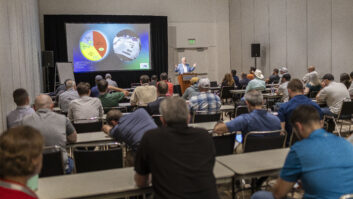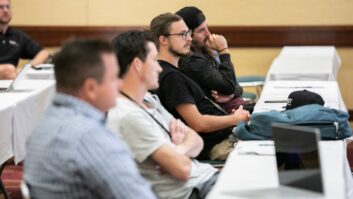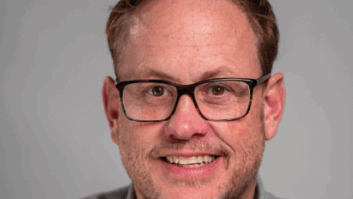Seth Rubenstein doesn’t have many fond memories of attending Hebrew School as a kid. The one exception is a book he read back then, called Stone Soup. That book was brought back to mind recently as he and his fellow members of the CEDIA board of directors faced the daunting challenge of re-engaging with alienated association volunteers.

Seth Rubenstein
The Stone Soup story is about fearful villagers whose hearts have been hardened after suffering harsh times. But when three monks, named Hok, Lok, and Siew, cleverly entice them to make soup from stones (in addition to a bunch of donated veggies), the villagers discover how much they are each capable of giving and how much more comes back in return when they do.
For Rubenstein, the Stone Soup parable compares to the recent struggles of CEDIA and the custom installation channel as the economy, housing market, and technology commoditization has taken its toll on the industry. His new mission as membership chair is a little bit like that of the monks as he works to re-engage veteran CEDIA volunteers in the inner workings of their trade association and recruits new members and volunteers to populate a completely revamped volunteer committee structure.
After several town hall meetings around the country revealed a general sense of alienation from long-time CEDIA volunteers, and a jaded attitude from non-CEDIA members about the value of joining the association, Rubenstein led board members in making drastic changes. The changes that he and other suggested would put volunteers back at the top of the CEDIA pyramid.
“[Chairman of the board Federico Bausone] said, ‘We have to bring back the councils,’ and by the end of the meeting we had created a new volunteer structure that was more streamlined and in line with our five-year strategic plan,” Rubenstein recalled. “And now I’m looking back through the CEDIA archives to contact past volunteers and recruit them to return and help us guide our new committees.”
According to CEDIA COO Don Gilpin, the board created a sense of urgency to get something done right on the spot, rather than handing its request back to CEDIA staff for later review.
“We said, ‘Let’s just stop the board meeting, roll our sleeves up, scratch this out, and come to an agreement that is at least 90 percent there. And we did that very thing,” Gilpen said. “We took a few hours, worked that night, and came back to the meeting with a proposed structure, that basically was ratified right then. There was a little bit of tweaking but we turned it around overnight to demonstrate that we hear the board’s demand for urgency, and we want the membership to hear that too.”

Don Gilpin
Gilpin pointed to a “perfect storm” of economic factors and organizational philosophy changes that contributed to the attrition of volunteers. They either stepped away from CEDIA to focus on keeping their own businesses afloat or became confused over how the role of the volunteer fit into the evolving CEDIA structure.
“That confusion, along with the Great Recession, really made our volunteer involvement drop off,” Gilpin said. “We always have had great volunteer support in our education realm, but the other areas were becoming more and more just staff driven and it was alienating many of the volunteers that have been with us for many years.”
Since November 2011, CEDIA has been following a five-year strategic plan, which is actually broken into one-year operating plans that list out the actual work that needs to be accomplished in a particular year. This roadmap provides each CEDIA department with a very clear listing of the projects it’s going to do, the budget associated with it, and a production timetable. The only thing missing was the volunteer input.
So during its June meeting in Chicago, the board agreed that it should build its new volunteer structure specifically around supporting the strategic plan. “It’s not going back in time and building an old structure,” Gilpin clarified. “We first looked at the strategic plan as the guiding principle of the association and built our volunteer committee around that plan.”
Referred to as “ad hocs” in board parlance, the committees represent Membership Development, Membership Programs, Professional Development, Emerging Technologies and Trends, and PR and Marketing.
As Gilpin explained it, the Membership Development committee will focus on growing and retaining membership. “We’re going to continually look at the value proposition of being a member,” Gilpin said, noting that new benefits for first-time CEDIA members will be added this summer. New members may be recruited from transitional and emerging markets like the security field, telecommunications, and the home health care space.
The Membership Programs ad hoc committee, on the other hand, will focus on actual products and services to make the CEDIA membership more valuable. These include education programs, market research, and public policy.
The Professional Development committee will be geared toward traditional education programs, as well as populating and marketing CEDIA’s resource center, which will be part of the associations new website for members (the new consumer site was launched earlier this summer to drive leads to members.)
“You’ll see hundreds of items there for e-delivery of education, white papers, electronic text books, articles, codes and standards,” Gilpin explained. “It’s all going to be a very easy-to-use electronic library for the industry, and we will continually build new education for emerging markets like networking and home health.”
Gilpin referred to CEDIA’s Emerging Technologies and Trends ad hoc as the association’s “rainmaker committee,” because it will include volunteers and professional staff that have a pulse on what’s on the horizon next, including emerging lifestyle or technology trends, and opportunities or threats.
“It’s almost like an early-warning system,” Gilpin said. “This committee identifies these trends and that information trickles down and becomes fodder for other goods and services like education or webinars or a member benefit that addresses this opportunity or threat.”
For the first time, CEDIA also will have a PR and Marketing committee composed of volunteers and staff with those specific skills and a particular bent on electronic delivery of content.

CEDIA’s new committee structure
Now that these committees have their names and missions, Rubenstein has begun reconnecting to all of CEDIA’s volunteers dating back to 2004 that may have been disenfranchised or ignored or just simply have more time to dedicate to volunteering, and asking them to contribute their ingredient to the CEDIA “stone soup.”
“Now that they have a new home and the work has been clearly defined, we want to re-engage the volunteer and really make it known to the membership that the CEDIA volunteer is really the lifeblood of CEDIA,” Gilpin said. “We really want to turn that pendulum back to more of a volunteer-led and staff-supported partnership.”
Gilpin said that ever since CEDIA’s new strategic plan was adopted, the board of directors has been crystal clear about its urgency. This is in spite of the fact that trade associations, he said, “are like great big ships” and it takes a while to turn the ship around.
“What the board has been explaining to me is that we do not have the luxury of a traditional turnaround time with CEDIA,” Gilpin said. “We need to be more urgent and more responsive to the membership that is struggling and demonstrate that there is a real value in being a member of CEDIA. So that urgency we hear loud and clear, and that’s why we’ve elevated the work to 2012 to do things like quickly creating a new cadre of benefits for a brand-new CEDIA member. That’s why we turned around this governance structure on a dime; it was urgent. We need to get out and demonstrate to our membership, particularly the long-time volunteers, that we are serious, and we’re creating a new structure where you have a say in the direction of this association. We want their participation.”
If you’re interested in volunteering or would like to sound off about something, Seth Rubenstein welcomes your input.







